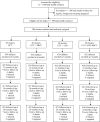Effectiveness of unconditional cash transfers combined with lipid-based nutrient supplement and/or behavior change communication to prevent stunting among children in Pakistan: a cluster randomized controlled trial
- PMID: 34612491
- PMCID: PMC8827069
- DOI: 10.1093/ajcn/nqab341
Effectiveness of unconditional cash transfers combined with lipid-based nutrient supplement and/or behavior change communication to prevent stunting among children in Pakistan: a cluster randomized controlled trial
Abstract
Background: In Pakistan, the prevalence of stunting among children younger than 5 y has remained above WHO critical thresholds (≥30%) over the past 2 decades.
Objectives: We hypothesized that an unconditional cash transfer (UCT) combined with lipid-based nutrient supplement (LNS) and/or social and behavior change communication (SBCC) will prevent stunting among children 6-23 mo of age.
Methods: This was a 4-arm, community-based cluster randomized controlled trial conducted in the district of Rahim Yar Khan, Pakistan. A total of 1729 children (UCT, n = 434; UCT + SBCC, n = 433; UCT + LNS, n = 430; and UCT + LNS + SBCC, n = 432) were enrolled at 6 mo of age and measured monthly for 18 mo until the age of 24 mo.
Results: At 24 mo of age, children who received UCT + LNS [rate ratio (RR): 0.85; 95% CI: 0.74, 0.97; P = 0.015) and UCT + LNS + SBCC (RR: 0.86; 95% CI: 0.77, 0.96; P = 0.007) had a significantly lower risk of being stunted compared with the UCT arm. No significant difference was noted among children who received UCT + SBCC (RR: 1.03; 95% CI: 0.91, 1.16; P = 0.675) in the risk of being stunted compared with the UCT arm. The pooled prevalence of stunting among children aged 6-23 mo was 41.7%, 44.8%, 38.5%, and 39.3% in UCT, UCT + SBCC, UCT + LNS, and UCT + LNS + SBCC, respectively. In pairwise comparisons, a significant impact on stunting among children in UCT + LNS (P = 0.029) and UCT + LNS + SBCC (P = <0.001) was noted compared with the UCT arm.
Conclusions: UCT combined with LNS and UCT + LNS + SBCC were effective in reducing the prevalence of stunting among children aged 6-23 mo in marginalized populations. UCT + SBCC was not effective in reducing the child stunting prevalence. This trial was registered at clinicaltrials.gov as NCT03299218.
Keywords: children; lipid-based nutrient supplement; social and behavior change communication; stunting; unconditional cash transfer.
© The Author(s) 2021. Published by Oxford University Press on behalf of the American Society for Nutrition.
Figures
References
-
- United Nations Children's Fund (UNICEF), World Health Organization, International Bank for Reconstruction and Development/The World Bank . Levels and trends in child malnutrition: key findings of the 2021 edition of the Joint Child Malnutrition Estimates. Geneva (Switzerland): World Health Organization; 2021.
-
- Martorell R, Horta BL, Adair LS, Stein AD, Richter L, Fall CH, Bhargava SK, Biswas SK, Perez L, Barros FC et al. Weight gain in the first two years of life is an important predictor of schooling outcomes in pooled analyses from five birth cohorts from low- and middle-income countries. J Nutr. 2010;140(2):348–54. - PMC - PubMed
-
- Martorell R, Khan LK, Schroeder DG. Reversibility of stunting: epidemiological findings in children from developing countries. Eur J Clin Nutr. 1994;48(1):S45–57. - PubMed
-
- Thomas D, Strauss J. Health and wages: evidence on men and women in urban Brazil. J Econometrics. 1997;77:159–85. - PubMed
Publication types
MeSH terms
Substances
Associated data
LinkOut - more resources
Full Text Sources
Medical
Miscellaneous


